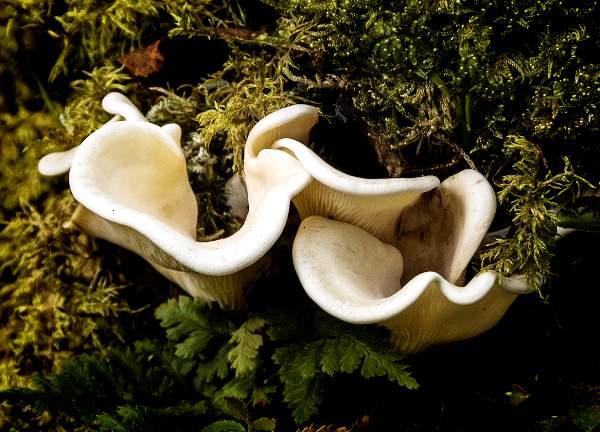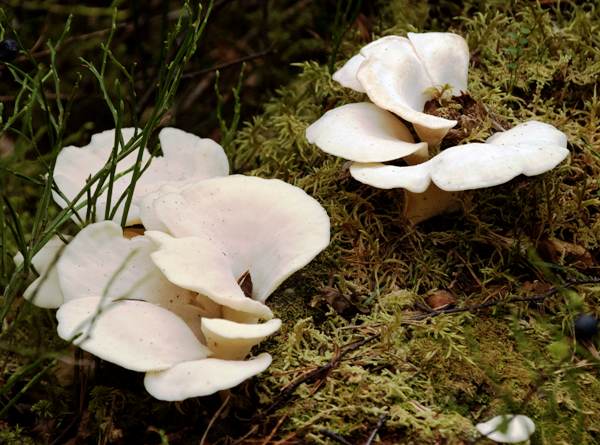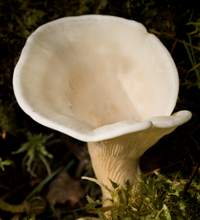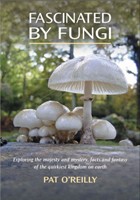Pleurocybella porrigens (Pers.) Singer - Angel's Wings
Phylum: Basidiomycota - Class: Agaricomycetes - Order: Agaricales - Family: Marasmiaceae
Distribution - Taxonomic History - Etymology - Identification - Culinary Notes - Reference Sources

Initially pure white, these funnel-like or oyster-like mushrooms need to be treated with great caution. They are toxic.
Description
Rather like funnel mushrooms but not actually forming a complete circle, because there is a side split right down to the base, the fruitbodies are usually stemless but sometimes have a very short sterile stem.
Habitat
These wood-rotting fungi grow on dead conifer stumps and falled trunks, often on quite old timber that is covered in moss.
Distribution
In Britain this species is found mainly in Scotland and northern England, with just occasional records in Wales and Ireland. Angel's Wings fungi also occur in northern mainland Europe, in cool parts of Asia, and in some regions of North America.

Taxonomic history
This oyster-like mushroom was first described validly in scientific literature in 1805 by Christiaan Hendrik Persoon, who established its basionym when he gave it the binomial name Agaricus porrigens. (Most gilled fungi were initially placed in the Agaricus genus in the early days of fungal taxonomy.) It was German-born American mycologist Rolf Singer who, in transferring it to the genus Pleurocybella in 1947, established its currently-accepted scientific name. Pleurocybella is a very small genus with just five species currently (January 2017) known to exist; it was esrtablished by Rolf Singer in 1947.
Synonyms of Pleurocybella porrigens (Pers.) Singer include Agaricus porrigensPers., Calathinus porrigens (Pers.) Quél., Pleurotellus porrigens (Pers.) Kühner & Romagn., and Pleurotus porrigens (Pers.) P. Kumm. The latter two names reflect the macroscopic similarity of Angel's Wings to Oyster mushrooms Pleurotus ostreatus and relatives.
Etymology
The genus name Pleurocybella comes from the Greek Pleuron, meaniung side by side, and from the diminutive of kýbe meaning head (a reference to the cap) - hence we get 'little sideways cap'.
The specific epithet porrigens is Latin and means extending or stretching out horizontally.
Identification guide
 |
Cap2 to 10cm across; white and smooth, sessile (stemless) split-sided incomplete funnel, sometimes shaped like a tongue but often with a lobed margin. Flesh thin, white. GillsIvory white. |
SporesGlobose, smooth, 5-6μm diameter; hyaline. Spore printWhite. |
|
Odour/taste |
Slight, pleasant. |
Habitat & Ecological role |
Saprobic, on well-rotted conifer timber, usually moss-covered and lying on the damp shaded forest floor. |
Season |
August to November in Britain and Ireland. |
Similar species |
Oyster Mushroom Pleurotus ostreatus is similar but usually has a slightly lilac spore print; it is also distinguished by thicker cap flesh and a short stem; its elongated spores are subcylindrical or slightly kidney shaped. |
Culinary notes
Once considered edible, these uncommon mushrooms have been known to cause fatalities in Japan, and so they should be treated as deadly poisonous.
Reference Sources
Fascinated by Fungi, 2nd Edition, Pat O'Reilly 2016, reprinted by Coch-y-bonddu Books in 2022.
British Mycological Society, English Names for Fungi
Funga Nordica, Henning Knudsen and Jan Vesterholt, 2008.
Dictionary of the Fungi; Paul M. Kirk, Paul F. Cannon, David W. Minter and J. A. Stalpers; CABI, 2008
Taxonomic history and synonym information on these pages is drawn from many sources but in particular from the British Mycological Society's GB Checklist of Fungi.
Acknowledgements
This page includes pictures kindly contributed by Shirley Kevern.
Fascinated by Fungi. Back by popular demand, Pat O'Reilly's best-selling 450-page hardback book is available now. The latest second edition was republished with a sparkling new cover design in September 2022 by Coch-y-Bonddu Books. Full details and copies are available from the publisher's online bookshop...

